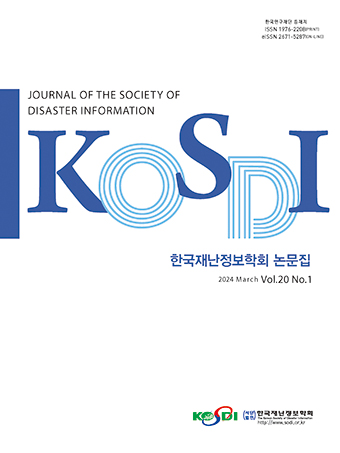Original Article
Abstract
References
Information
Purpose: This study aims to propose measures for the prevention of fire and explosion accidents within manufacturing facilities by improving the existing classification criteria for hazardous locations based on the leakage patterns of flammable liquids. The objective is to suggest ways to safely manage ignition sources and combustible materials. Method: The hazardous locations were calculated using “KS C IEC 60079-10-1,” and the calculated explosion hazard distances were visualized in 3D. Additionally, the formula for the atmospheric dispersion of flammable vapors, as outlined in “P-91-2023,” was utilized to calculate the dispersion rates within the hazardous locations represented in 3D. Result: Visualization of hazardous locations in 3D enabled the identification of blind spots in the floor plan, facilitating immediate recognition of ignition sources within these areas. Furthermore, when calculating the time taken for the Lower Explosive Limit (LEL) to reach within the volumetric space of the hazardous locations represented in 3D, it was found that the risk level did not correspond identically with the explosion hazard distances. Conclusion: Considering the atmospheric dispersion of flammable liquids, it was concluded that safety management should be conducted. Therefore, a method for calculating the concentration values requiring detection and alert based on realistically achievable ventilation rates within the facility is proposed.
연구목적: 인화성 액체의 누출형태에 따라 제조업 사업장 내 화재·폭발사고를 예방하기 위해 기존 폭발위험장소 구분도를 개선하여 점화원 및 가연물을 안전하게 관리할 수 있는 방안을 제안하고자 한다. 연구방법: 「KS C IEC 60079-10-1」를 사용하여 폭발위험장소를 계산했으며, 계산된 폭발위험거리를 3D로 폭발위험장소를 구현하였다. 또한, 3D를 통해 구현된 폭발위험장소 내 인화성 증기의 대기확산량을 계산하기 위해 「P-91-2023」 액체의 대기확산량 공식을 활용하였다. 연구결과: 폭발위험장소를 3D로 표현했을 때 평면도의 사각지대를 확인할 수 있었으며, 폭발위험장소 내 점화원을 즉각적으로 확인 가능하였다. 다음으로 가연물은 3D로 나타난 폭발위험장소 체적 내 LEL 도달시간을 계산했을 때, 폭발위험거리와 동일하게 위험도가 나타나지 않았다. 결론: 인화성 액체의 대기확산량을 고려하여 안전관리가 이루어져야 할 것으로 판단하였다. 따라서 사업장에서 현실적으로 시행할 수 있는 환기량으로 감지·경보가 필요한 농도값을 계산하는 방법을 제안하였다.
- Chang B.-K. (2009). "A study on the difference between drawings and realized structure." Journal of the Architectural Institute of Korea, Vol. 25, No. 12, pp. 3-11.
- GTSC (2022). Classification Code for Explosive Hazardous Area on Gas Facility (KGS GC101 2022). https://cyber.kgs.or.kr/codesrc/kgscode_pdf/2022/GC101_220830.pdf.
- Jung, Y.-J., Lee, C.-J. (2018). "A study on the estimation model of liquid evaporation rate for classification of flammable liquid explosion hazardous area." Journal of the Korean Society of Safety, Vol. 33, No. 4, pp. 21-29.
- Kang, G.-Y. (2023). State of Major Disasters in 2022. Current Status and Tasks for One Year of Enforcement of the Serious Disaster Punishment Act, MoEL, Sejong, Republic of Korea.
- Kim, D.-Y., Chon, Y.-W., Lee, I.-M., Hwang, Y.-W. (2017). "A study on the improvement of classification of explosion hazardous area using hypothetic volume through release characteristic." Journal of the Korea Safety Management & Science, Vol. 19, No. 2, pp. 31-39.
- KOSHA (2012). Technical Guidelines for Chemical Plant and Process Design (KOSHA GUIDE D-37-2012). https://www.kosha.or.kr/kosha/info/searchTechnicalGuidelines.do.
- KOSHA (2019). Technical Guidelines for Industrial Ventilation Systems (KOSHA GUIDE W-1-2019). https://www.kosha.or.kr/kosha/info/searchTechnicalGuidelines.do.
- KOSHA (2020). Technical Guidelines for Gas Leak Detection and Alarm Equipment Installation and Maintenance (KOSHA GUIDE P-166-2020). https://www.kosha.or.kr/kosha/info/searchTechnicalGuidelines.do.
- KOSHA (2023). Guidelines for Calculation of Chemical Exposure Index (CEI)(KOSHA GUIDE P-91-2023). https://www.kosha.or.kr/kosha/info/searchTechnicalGuidelines.do.
- KSA (2022). Explosive atmospheres - Part 10-1:Classification of areas - Explosive gas atmospheres (KS C IEC60079-10-1). https://e-ks.kr/streamdocs/view/sd;streamdocsId=72059252330962804.
- Lee, J.-Y., Cho, K.-S., Yoon, H.-C., Son, D.-S. (2016). Case Study on Fire (Explosion) Incident at Raw Pharmaceutical Manufacturing Plant. KOSHA, Ulsan, Republic of Korea.
- Moon, J.-S., Lee, J.-H. (2019). "Development of walk-down performance procedures for fire modeling of nuclear power plants based on deterministic fire protection requirements." Fire Science and Engineering, Vol. 33, No. 6, pp. 43-52. 10.7731/KIFSE.2019.33.6.043
- NICS (2023). NCIS [Available from: https://icis.me.go.kr/pageLink.do;jsessionid=mBsq9lporrR0DPXAkxj89Bss.icis_ipotal11.]
- Seo D.-H., Lee K.-W., Han O.-S., CHol Y.-R. (2018). Investigation on the Causes of Fire and Explosion Accidents during Usual and Unusual Work, Utilizing Accident Cases at Chemical Plants. OSHRI, Dajeon, Republic of Korea.
- Sim, W.-S. (2022). Minister of Employment and Labor Issues Urgent Directive Regarding Explosion Incident at SK GeoCentric Co., Ltd. MoEL, Press Releases, Sejong, Republic of Korea.
- Yu, W.-J., Kim, B.-J., Lee, J.-w., Cho, K.-S., Park, K.-S. (2020). "A study on the optimum estimation of flammable liquid release rate for the classification of hazardous area." Korean Journal of Hazardous Materials, Vol. 8, No. 2, pp. 9-18. 10.31333/kihm.2020.8.2.9
- Publisher :The Korean Society of Disaster Information
- Publisher(Ko) :한국재난정보학회
- Journal Title :Journal of the Society of Disaster Information
- Journal Title(Ko) :한국재난정보학회논문집
- Volume : 20
- No :1
- Pages :47-59
- DOI :https://doi.org/10.15683/kosdi.2024.3.31.047



 Journal of the Society of Disaster Information
Journal of the Society of Disaster Information






